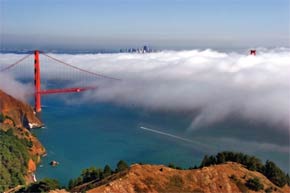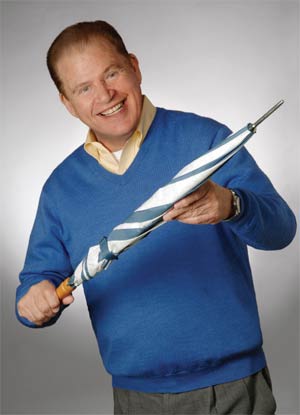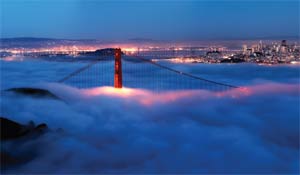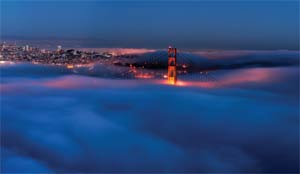 In the 1980s, I was what some people called a “snow farmer.” I owned a transportation company back then and part of my business included running snow ski trips during the winter. Weather and road conditions permitting, we ran buses five days a week to six different ski resorts in the Sierras.
In the 1980s, I was what some people called a “snow farmer.” I owned a transportation company back then and part of my business included running snow ski trips during the winter. Weather and road conditions permitting, we ran buses five days a week to six different ski resorts in the Sierras. 
There was a problem with snow farming however—sometimes we didn’t have enough snow… sometimes we had too much. Our business lived or died by the prevailing weather conditions, so early on we became obsessed weather-watchers. When storms approached, we had to decide if our buses should run or if trips should be cancelled.
We followed every weather forecast we could from TV and radio—even a weather band radio that provided around-the-clock forecasts from NOAA, the National Oceanic and Atmospheric Administration
 Frequently, the reports differed slightly—thus the reason we followed varied sources. A difference of just six to twelve hours in predicting when a storm would hit was of great importance to us in deciding whether or not to cancel a trip. Make the wrong call and we risked having 47 disappointed or even angry skiers expecting refunds.
Frequently, the reports differed slightly—thus the reason we followed varied sources. A difference of just six to twelve hours in predicting when a storm would hit was of great importance to us in deciding whether or not to cancel a trip. Make the wrong call and we risked having 47 disappointed or even angry skiers expecting refunds.
While we’d follow many weather reports, one reporter stood out that we looked forward to watching. His accuracy was on par with a select group who got things right more often than not, but what set him apart from all the others—what made him worth tuning in for—was that he was also very entertaining. Lloyd Lindsay Young’s forecast segment on KGO TV channel 7 was downright fun to watch.
Young started every broadcast by mentioning a different city or town with a loud voice trumpeting, “Hellooooo _____!” Part of the fun in watching Lloyd was to discover which town or city he would honor with his boisterous call-out. He’d then point to his weather map with a “unique” pointer of some sort, using something new every time—from common items like a golf club, to more exotic pointers, like a plastic, pink flamingo or a blow-up lobster.
After several years, Lloyd left KGO—and I left the transportation business. Fast forward to today. I publish ALIVE, and Lloyd now works in radio, still doing weather reports on News Talk 910, KKSF in San Francisco. When a good friend of mine, Chuck Waltman, a senior engineer for Clear Channel, happened to mention that he sometimes works with Lloyd Lindsay Young, I enthusiastically asked him to see if he could arrange an interview. I was soon to meet with what many—me included—consider, “The Best Weatherman Ever!”
EJ: How did you get started in broadcasting?
LLY: I grew up in Southern California. I didn’t really know what I wanted to do in high school and attended Los Angeles City College. They had a broadcast studio. I decided then that I wanted to work in broadcasting and to follow my dream. I made $60 a week in 1961—my first job in broadcasting. Then in 1971, a friend who was doing weather at a TV station in Idaho Falls said I should come up and audition. I didn’t have a tape so they had me do a live audition–on the air—and they liked it. They hired me on the spot and based on that and my radio experience. “KIFI, Idaho Falls, Pocatello, Blackfoot!”
In a small market like that, you do everything! In Jackson Wyoming I did hundreds of schools, rotary clubs, lions clubs, girl scout tours—you name it.
EJ: I used to watch you when you were on KGO channel 7 back in the 1980s. How did that come about?
LLY: I was in Idaho Falls when the GM at ABC in San Francisco called. There I was, working in the 163rd market and the number five market comes calling. Man, you know you’ve hit the big time! I was at KGO TV from 1981 to 1983. I worked with Pete Giddings. He was the “serious” meteorologist at the station. I was more into entertaining.
EJ: I would think that that would be an advantage. Your entertaining brings another dimension to weather reporting. It draws people in. I think it makes you a stand out weather broadcaster!
LLY: Well, thank you. The news is pretty serious stuff usually so I figured if I could offer a little levity, I would. So, I started using the pointers. My son calls it “infotainment.” It’s all about ratings! Of course, when the weather is serious, I’m serious. When I was in Indiana we’d break into programming and issue tornado warnings. People would call the station and complain that we interrupted their soap operas!
EJ: Tell me, how did you happen to come up with your big “HELLOOO” bit.
LLY: That all started by accident. I was working in Idaho Falls in television, and one day—and I don’t know what possessed me—but I knew there were viewers up in Wyoming, so I just blurted out “Hello Jackson Hole!” A bunch of people called the station. I thought, wait a minute, I might be on to something. The next day: “Hello Pocatello!” and a bunch of people called in again. The rest is history.
EJ: So, it was something you sort of calculated. That was pretty smart.
LLY: Then I started wondering, all these little, itty-bitty towns—towns with 500 people—I’d go to schools and have kids appear on camera. I’d tell the kids, “YOU are going to be on television tonight—have your parents watch!” In a mall market, it was a terrific way to generate ratings.
EJ: So where else have you worked and how does this area compare weather-wise to other places you’ve worked?
LLY: After I left channel 7 KGO in San Francisco I was on TV in New York for 12 years. I lived in New Jersey. The New York metro area is the very best and the very worst of everything Here, it doesn’t get cold here—like Butte Montana or Buffalo, and the heat and the humidity in the Midwest can be unbearable—very oppressive. I’ve lived in a lot of places and I’d say the Bay Area is the nicest place in the country. People here can’t imagine what real bad weather is. The thing is, you’ve got to be willing to move a lot when you’re in this business. You won’t start in a major market like New York or San Francisco.
EJ: What about the weather here? It seems pretty basic. What’s the most challenging thing about our weather?
LLY: The challenge here in the Bay Area is all the mini-climates. In the summer it can be 102° in the East Bay and 60° in the city. The fog is the trickiest part here—when it is coming in—for example, in September and October when it gets warm and the city gets the offshore flow—the the air is going from land to sea—it’s trying to predict when that’s going to reverse, because once that wind shifts and it starts blowing off the ocean—the onshore flow—it can drop 20° in a half hour. That’s the hard part—trying to pinpoint when that’s going to happen.
EJ: So what about the science? What’s different today and why are some weather broadcasters’ predictions different?
LLY: A lot has changed—technology, computers, satellites, radar. The computer models today are much better. Today the degree of accuracy is five to seven days which is much better than it was 30 to 40 years ago. But we all get the same information from the same sources but all weather reporters interpret the same information differently. Weather is not an exact science. It’s an educated guess. The thing is, when we get it wrong we hear about it but when the National Weather Service gets it wrong, nothing happens—they have no accountability.
EJ: How about the global warming debate? Is it getting hotter and if so, is it man caused?
LLY: I can tell you that 2012 has gone down as the hottest year since 1893 — on average. I think it’s partly man caused and partly cyclical. There are “heat islands” — cities tend to be warmer due to all the cement and pavement. But it will take hundreds of years before it causes anything serious. I do know that the winters were more severe thee first half of the 20th century than the 2nd half.
After television, Young transitioned to radio weather in California. He was with KGO 810 for many years and is now with News Talk 910 in San Francisco. Young also does a national weather broadcast for iHeart Radio, three times each day. “I did TV for 28 years,” says Young, “Now I have a good face for radio.”
He maintains the same style on radio that made him famous on TV, including his over-the-top “Helloooooo!” unless the weather gets too serious for that personality.
At the height of his popularity Young amassed an enormous collection of weather pointers used during his television reports. Viewers sent in thousands of objects including plastic alligators, a launching rocket, a mannequin leg (complete with stiletto), and petrified animal body parts. One image seared into my memory is the image of Lloyd Lindsay Young using a six foot model of the Empire State Building, complete with its own King Kong attached, pointing to his weather map!
Young has combined his Broadcasting degree with his love of weather. “I am not a serious meteorologist. But on the other hand, I know a lot about the weather, because I’m obsessed with it—I even follow it on my days off. And I love bad weather—it really gets my juices going! I’m not wishing devastation on anybody, but a nice storm coming in really gets me going!”
I remember Lloyd from the mid-late 80s WOR W/ Sara Lee Kesler ……Gunisen Colorado was another location he used to hellooooo a lot …….Science !!!! He made weather interesting and enjoyable…People around here still do that bit……Hellooooo
HI, I AM TRYING TO FIND OUT IF PETE GIDDINGS IS STILL WITH US , I THOUGHT I HEARD ABOUT 10 YEARS AGO HE HAD PASSED AWAY??? I ALWAYS WATCHED HIM AND MY HUSBAND TO SO ENJOYED ALL THE INFO HE SAID. THANK YOU~JEAN VAN BUSKIRK, cA~~~~~~~~